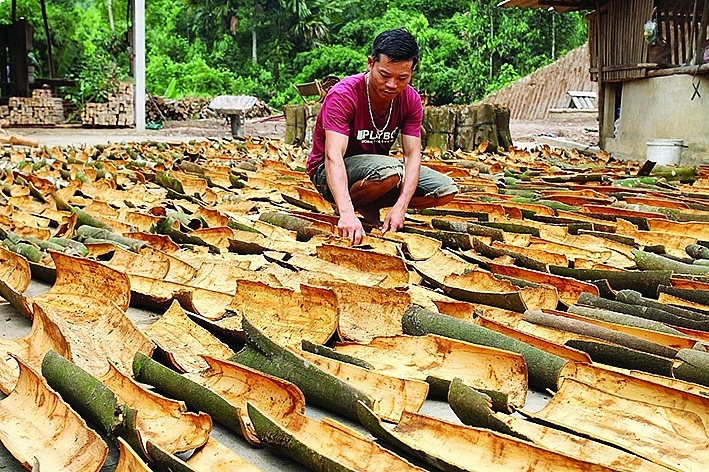Let Vietnamese spices dominate key markets
Transforming sustainable farming processes and clear traceability is an indispensable requirement to build a strategy to develop a sustainable and globally competitive Vietnamese spice industry.
 |
|
In recent years, cinnamon has become a high-value key crop, a precious raw material for production in the pharmaceutical industry, cosmetics, and handicraft processing... Photo: TTXVN |
There is no sustainable development strategy
Mr. Nguyen Nhu Tiep said that Vietnam has great potential for producing spices such as cinnamon, anise, and other herbs typical of Asian cuisine. In addition to key markets, markets with many Asian communities are also a new direction for potential customers in consuming tropical specialties and spice products. Due to the trend of increasing demand for raw materials in the food, cosmetics, and pharmaceutical industries... currently, Vietnamese cinnamon and anise are consumed strongly in many South Asian regions (India, Bangladesh), and China. East (UAE, Pakistan), East Asia (Japan, Taiwan (China), Korea, USA and European Union (EU) countries).
Mr. Le Viet Anh, Chief of Office of the Vietnam Pepper and Spice Association (VPSA), said that market demand for spices is high and Vietnam has the most advantages in exporting spices. is when there are Free Trade Agreements such as EVFTA, and CPTPP... However, Vietnam's spice industry faces many challenges. Specifically, except for pepper, other spices such as cinnamon, star anise, and chili... do not have a sustainable development strategy. Meanwhile, businesses lack the technology and capital to invest in deep processing to increase product value. Geopolitical instability factors may continue to cause price instability rather than supply and demand factors, while competition from other producing countries such as pepper in Brazil, cinnamon in Indonesia and China persists. In addition, the unpredictable developments of climate change are also the main challenge for the agricultural industry globally while costs continue to increase, which will greatly impact supply...
Assessing world spice market trends to orient production in Vietnam, a representative of the Department of Quality, Processing and Market Development said that items and products from cinnamon, anise and medicinal plants is receiving increasing attention and expanding export markets due to changes in consumer awareness, opinions and tastes towards a green, clean, healthy and immune-boosting lifestyle. Consumer trends are moving towards safe and environmentally friendly products and consumer behavior has adjusted towards sustainable development, ensuring traceability, and creating value-added products. increase, ensure quality according to market requirements and finally apply digital platforms and technology to the supply chain and value chain.
Transparency in production to enhance product value
From a market perspective, Mr. Tran Van Cong, Vietnamese Agricultural Counselor in the European Union (EU), said that Europe is one of the leading importing regions of spices and flavorings, accounting for about 1/4 of the world's total imports, with more than 95% of imports from outside Europe coming from developing countries in which imports from developing countries alone reached 1.8 billion Euro and accounted for 60% of Europe's imports in the period 2019-2021, an increase of 9%/year. In addition, average import prices in Europe are also higher than in most other regions. For example, the average price of imported spices in Europe is almost twice as high as the price in Asia. This makes Europe a target market for exporters from developing countries. However, exporting to this market needs to pay attention to a number of requirements such as strict control of toxic substances, allergens, pesticide residues, heat treatment, plant quarantine, and certification of food safety, transparent supply chain...
Regarding another key market of Vietnamese spices, in the United States, Mr. Pham Quang Huy, Counselor for Vietnamese Agriculture in the United States, shared that the demand for spices in this market is increasing due to the demand for increased resistance and protect consumers' health after COVID-19. Increasing the market share of Vietnamese spices in this market as well as making Vietnam the destination of choice in the global spice supply chain, Mr. Huy believes that besides raw products, it is necessary to diversify products. spices serving the food industry, cosmetics, pharmaceuticals... Particularly for cuisine, it is possible to increase the recognition of spices by combining them with fish sauce next to dishes such as pho, spring rolls are already popular and loved in this market of hundreds of millions of people.
According to Mr. Huy, spice plants not only bring economic value but are also a valuable, indigenous genetic resource, helping to eradicate hunger and reduce poverty, contributing to the conservation of biodiversity under the forest canopy... These are the factors important things that businesses can include to promote Vietnamese spice products in the face of green consumption trends, environmental protection, and emission reduction in the US market.
Mr. Nguyen Van Hoi, Director of the Institute of Strategic and Policy Research (Ministry of Industry and Trade) said that promoting spice exports needs to be associated with promoting research and application of technology and innovation, especially the technologies of the 4.0 Technology Revolution. Next is to innovate and diversify trade promotion methods for spice exports through promoting the application of information technology and digital transformation in trade promotion activities.
In addition, Mr. Hoi said that it is necessary to increase the level of innovation in exported spice products and focus on building and developing brands for potential Vietnamese export spice products. Finally, increase the proportion of exported spice products with added value, science and technology content, green economy products, circular economy, and environmentally friendly products.








